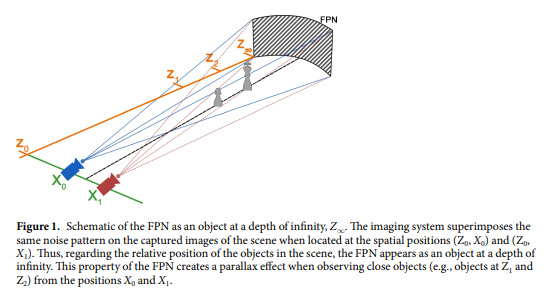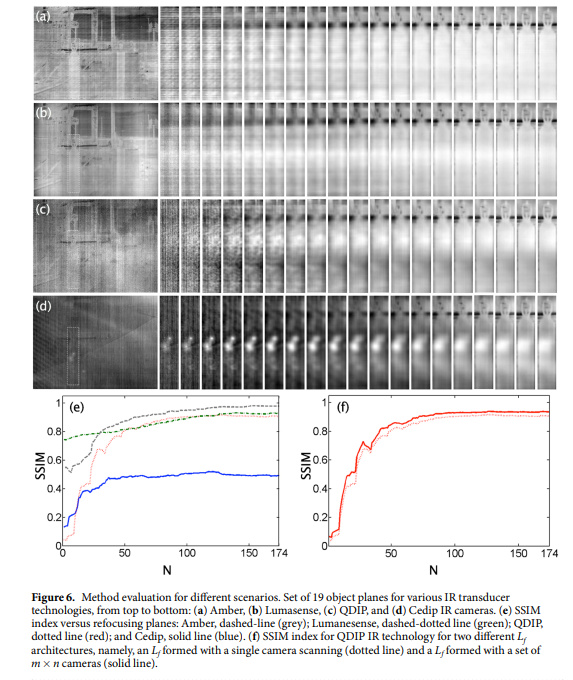
Home List your patent My account Help Support us
Digital Refocusing Process
[Category : - Audio - Video]
[Viewed 907 times]
Digital imaging technologies based on an array of electromagnetic sensors—used in scientific (astronomy, tomography, thermography, and microscopy), industrial, and military (vision systems) applications, among other fields— pose an image noise problem called fixed-pattern noise (FPN), which is similar as looking at the image through a dirty or scratched window.
FPN is attributed to sensor manufacturing imperfections, inmogeneous pixel responses, dark detector currents, and typical reading architectures. This problem is especially sensitive in low-energy photonic imaging such as infrared (IR) images, for which correction techniques such as calibration-based techniques (blackbody radiation two-point (BBRTP)) or scene-based techniques are necessary. These solutions are expensive (they require costly and bulky additional equipment) and/or use many electronic and/or electrical resources.
Technology Overview
This technology consists of a process comprising a special arrangement of the electromagnetic sensors array of the cameras, so that the image can be digitally refocused by means of any digital control algorithm existing in the market, thus allowing the elimination of FPN in effective images, which is especially useful for low-energy photon imaging systems.
FPN was shown to behave like an object at infinity depth when a light field is captured by an imaging system (Figure 1). Thus, this matrix arrangement changes the way we perceive the image —formed from the capture of a collection of images in the same scene with a relative displacement between them (light field camera)— by fixing the focus on a nearby plane and shifting or locating the FPN in the farthest or infinity plane of the image, thus removing the distortion caused in the image of interest.
This process allows its integration into hardware architecture configurations for cameras, in digital noise removal in infrared images or in light field camera systems (mobile phones and autonomous car cameras), rendering clear enough images without the necessity to enhance the image using subsequent correction techniques such as BBRTP or scene-based techniques.
The process was validated with commercial infrared cameras that use different technologies (Cedip, Amber, Lumasense and quantum-dots infrared photodetector (QDIP)), thus increasing the noise reduction level -quantified by the structural similarity index (SSIM)- to 0.86. This means, that the human eye will not able to perceive the difference between an image corrected with BBRTP and an image refocused using the process proposed above. Open source software were also used, yielding, in all cases, a high noise removal (Figure 2).
Benefits
The results using this process are comparable to the results obtained with high-precision radiometric applications.
It eliminates the need to correct the image produced by the camera using calibration-based techniques (which use costly equipment) or scene-based techniques.
It works on images with different fixed-pattern noise structures.
It does not require knowledge of the transducer physical parameters, the movement scene, or the presence of dark body sources.
Finally, the proposed process has proven to be useful for different cameras and configurations, such as cooled and uncooled long and medium wave IR range, and make way for the creation of new low-energy photon cameras capable of removing noise using digital refocusing.
Applications
This solution is a different approach to solving the FPN problem in effective imaging, and is useful for:
Infrared imaging systems used in surveillance, maritime navigation, road safety, predictive maintenance, disease control (e.g., non-invasive tool to detect variations in skin temperature, cancer detection), military and defence, among other fields.
Terahertz imaging systems (THz) considered promising for the challenge of carrying out non-destructive inspections of industrial products, for example, in sorting industries (e.g., food, waste management), safety and applied analytics.
Hyperspectral infrared systems with visible light, used in space, satellite and remote sensing applications.
Among the potentially attractive markets are the global infrared camera market, which is estimated to grow at a CAGR of 7% between 2020 and 2026, and the global light field cameras market (3D cameras or plenoptic cameras).
Financial information
Opportunity
The university is currently looking for potential licensees and/or co-developers who want to bring this solution to the market.
Researchers are available to validate and prototype whatever is necessary, and coordinate research activities or joint developments with the research team.
The patent, titled "A process allowing the removal through digital refocusing of fixed-pattern noise in effective images formed by electromagnetic sensor arrays in a light field", owned by the University of Concepción, protects the process allowing the removal of FPN, its use in a single array of electromagnetic sensors and its use in multiple electromagnetic radiation focusing systems.
Asking price:
Make an offer
Make an offer


[ Home | List a patent | Manage your account | F.A.Q.|Terms of use | Contact us]
Copyright PatentAuction.com 2004-2017
Page created at 2025-11-26 2:53:25, Patent Auction Time.
 Patent publications:
Patent publications: US 10891716
US 10891716 EP 3386188
EP 3386188 Great invention
Great invention